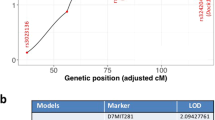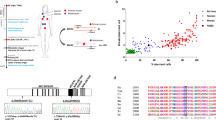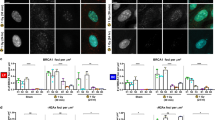Abstract
BRCA1 mutation carriers have an 85% lifetime risk of breast cancer and 60% for ovarian cancer. BRCA1 facilitates DNA double-strand break repair, and dysfunction of BRCA1 leads to hypersensitivity to DNA damaging agents and consequently genomic instability of cells. In this communication, we have examined the tumor incidence and survival of Brca1 heterozygous female mice. Brca1 heterozygotes appear to have a shortened life span with 70% tumor incidence. Lymphoma, but not ovarian and mammary gland tumors, occurs commonly in these mice. After a whole-body exposure to ionizing radiation, Brca1 heterozygous mice have a 3–5-fold higher incidence specific to ovarian tumors, but not lymphoma, when compared with the Brca1+/+ mice. All the tumors from heterozygous mice examined retain the wild-type allele and the cancer cells express Brca1 protein, precluding the chromosomal mechanism for loss of heterozygosity of Brca1 locus. Although the manifestation of BRCA1 haploinsufficiency may be different between human and mouse, this study suggests that women carrying Brca1 mutations may be more prone to ovarian tumor formation after IR exposure than nonmutation carriers.
This is a preview of subscription content, access via your institution
Access options
Subscribe to this journal
Receive 50 print issues and online access
$259.00 per year
only $5.18 per issue
Buy this article
- Purchase on Springer Link
- Instant access to full article PDF
Prices may be subject to local taxes which are calculated during checkout


Similar content being viewed by others
References
Baeyens A, Thierens H, Claes K, Poppe B, de Ridder L, Vral A . (2004). Chromosomal radiosensitivity in BRCA1 and BRCA2 mutation carriers. Int J Radiat Biol 80: 745–756.
Baria K, Warren C, Roberts SA, West CM, Evans DG, Varley JM et al. (2001) Correspondence re: A. Rothfuss et al., Induced micronucleus frequencies in peripheral blood lymphocytes as a screening test for carriers of a BRCA1 mutation in breast cancer families. Cancer Res 61: 5948–5949.
Baldeyron C, Jacquemin E, Smith J, Jacquemont C, De Oliveira I, Gad S et al. (2002). A single mutated BRCA1 allele leads to impaired fidelity of double strand break end-joining. Oncogene 21: 1401–1410.
Brekelmans CT, Seynaeve C, Bartels CC, Tilanus-Linthorst MM, Meijers-Heijboer EJ, Crepin CM et al. (2001). Effectiveness of breast cancer surveillance in BRCA1/2 gene mutation carriers and women with high familial risk. J Clin Oncol 19: 924–930.
Burke W, Daly M, Garber J, Botkin J, Daly M, Garber J et al. (1997). Recommendations for follow-up care of individuals with an inherited predisposition to cancer. II. BRCA1 and BRCA2. Cancer Genetics Studies Consortium. JAMA 277: 997–1003.
Cao L, Li W, Kim S, Brodie SG, Deng CX . (2003). Senescence, aging, and malignant transformation mediated by p53 in mice lacking the Brca1 full-length isoform. Genes Dev 17: 201–213.
Couch FJ, DeShano ML, Blackwood MA, Calzone K, Stopfer J, Campeau L et al. (1997). BRCA1 mutations in women attending clinics that evaluate the risk of breast cancer. N Engl J Med 336: 1409–1415.
de Boer J, Andressoo JO, de Wit J, Huijmans J, Beems RB, van Steeg H et al. (2002). Premature aging in mice deficient in DNA repair and transcription. Science 296: 1276–1279.
Deng CX, Xu X . (2004). Generation and analysis of Brca1 conditional knockout mice. Methods Mol Biol 280: 185–200.
Easton DF, Ford D, Bishop DT . (1995). Breast and ovarian cancer incidence in BRCA1-mutation carriers. Breast Cancer Linkage Consortium. Am J Hum Genet 56: 265–271.
Fletcher SW, Black W, Harris R, Rimer BK, Shapiro S . (1993). Report of the International Workshop on Screening for Breast Cancer. J Natl Cancer Inst 85: 1644–1656.
Foray N, Randrianarison V, Marot D, Perricaudet M, Lenoir G, Feunteun J . (1999). Gamma-rays-induced death of human cells carrying mutations of BRCA1 or BRCA2. Oncogene 18: 7334–7342.
Friedenson B . (2000). Is mammography indicated for women with defective BRCA genes? Implications of recent scientific advances for the diagnosis, treatment, and prevention of hereditary breast cancer. MedGenMed 2: E9.
Goldfrank D, Chuai S, Bernstein JL, Ramon Y, Cajal T, Lee JB et al. (2006). Effect of mammography on breast cancer risk in women with mutations in BRCA1 or BRCA2. Cancer Epidemiol Biomarkers Pre 15: 2311–2313.
Goss PE, Sierra S . (1998). Current perspectives on radiation-induced breast cancer. J Clin Oncol 6: 338–347.
Greenblatt MS, Chappuis PO, Bond JP, Hamel N, Foulkes WD . (2001). TP53 mutations in breast cancer associated with BRCA1 or BRCA2 germ-line mutations: distinctive spectrum and structural distribution. Cancer Res 61: 4092–4097.
Haffty BG, Harrold E, Khan AJ, Pathare P, Smith TE, Turner BC et al. (2002). Outcome of conservatively managed early-onset breast cancer by BRCA1/2 status. Lancet 359: 1471–1477.
Hashizume R, Fukuda M, Maeda I, Nishikawa H, Oyake D, Yabuki Y et al. (2001). The RING heterodimer BRCA1-BARD1 is a ubiquitin ligase inactivated by a breast cancer-derived mutation. J Biol Chem 276: 14537–14540.
Kirova YM, Vilcoq JR, Asselain B, Sastre-Garau X, Fourquet A . (2005). Radiation-induced sarcomas after radiotherapy for breast carcinoma: a large-scale single-institution review. Cancer 104: 856–863.
Kote-Jarai Z, Salmon A, Mengitsu T, Copeland M, Ardern-Jones A, Locke I et al. (2006). Increased level of chromosomal damage after irradiation of lymphocytes from BRCA1 mutation carriers. Br J Cancer 94: 308–310.
Kotsopoulos J, Chen Z, Vallis KA, Poll A, Ainsworth P, Narod SA . (2007). DNA repair capacity as a possible biomarker of breast cancer risk in female BRCA1 mutation carriers. Br J Cancer 96: 118–125.
Li S, Chen PL, Subramanian T, Chinnadurai G, Tomlinson G, Osborne CK et al. (1999). Binding of CtIP to the BRCT repeats of BRCA1 involved in the transcription regulation of p21 is disrupted upon DNA damage. J Biol Chem 274: 11334–11338.
Li S, Ting NS, Zheng L, Chen PL, Ziv Y, Shiloh Y et al. (2001). Functional link of BRCA1 and ataxia telangiectasia gene product in DNA damage response. Nature 406: 210–215.
Liu CY, Flesken-Nikitin A, Li S, Zeng Y, Lee WH . (1996). Inactivation of the mouse Brca1 gene leads to failure in the morphogenesis of the egg cylinder in early postimplantation development. Genes Dev 10: 1835–1843.
Metcalfe KA, Lynch HT, Ghadirian P, Tung N, Olivotto IA, Foulkes WD et al. (2005). The risk of ovarian cancer after breast cancer in BRCA1 and BRCA2 carriers. Gynecol Oncol 96: 222–226.
Miki Y, Swensen J, Shattuck-Eidens D, Futreal PA, Harshman K, Tavtigian S et al. (1994). A strong candidate for the breast and ovarian cancer susceptibility gene BRCA1. Science 266: 66–71.
Narod SA, Lubinski J, Ghadirian P, Lynch HT, Moller P, Foulkes WD et al. (2006). Screening mammography and risk of breast cancer in BRCA1 and BRCA2 mutation carriers: a case-control study. Lancet Oncol 7: 402–406.
Neuhausen SL, Marshall CJ . (1994). Loss of heterozygosity in familial tumors from three BRCA1-linked kindreds. Cancer Res 54: 6069–6072.
Nikitin AYu, Lee WH . (1996). Early loss of the retinoblastoma gene is associated with impaired growth inhibitory innervation during melanotroph carcinogenesis in Rb+/− mice. Genes Dev 10: 1870–1879.
Pao GM, Janknecht R, Ruffner H, Hunter T, Verma IM . (2000). CBP/p300 interact with and function as transcriptional coactivators of BRCA1. Proc Natl Acad Sci USA 97: 1020–1025.
Rothfuss A, Schutz P, Bochum S, Volm T, Eberhardt E, Kreienberg R et al. (2000). Induced micronucleus frequencies in peripheral lymphocytes as a screening test for carriers of a BRCA1 mutation in breast cancer families. Cancer Res 60: 390–394.
Salim EI, Wanibuchi H, Morimura K, Wei M, Mitsuhashi M, Yoshida K et al. (2003). Carcinogenicity of dimethylarsinic acid in p53 heterozygous knockout and wild-type C57BL/6J mice. Carcinogenesis 24: 335–342.
Schildkraut JM, Bastos E, Berchuck A . (1997). Relationship between lifetime ovulatory cycles and overexpression of mutant p53 in epithelial ovarian cancer. J Natl Cancer Inst 89: 932–938.
Scully R, Anderson SF, Chao DM, Wei W, Ye L, Young RA et al. (1997). BRCA1 is a component of the RNA polymerase II holoenzyme. Proc Natl Acad Sci USA 94: 5605–5610.
Shanley S, McReynolds K, Ardern-Jones A, Ahern R, Fernando I, Yarnold J et al. (2006). Late toxicity is not increased in BRCA1/BRCA2 mutation carriers undergoing breast radiotherapy in the United Kingdom. Clin Cancer Res 12: 7025–7032.
Shen SX, Weaver Z, Xu X, Li C, Weinstein M, Chen L et al. (1998). A targeted disruption of the murine Brca1 gene causes gamma-irradiation hypersensitivity and genetic instability. Oncogene 17: 3115–3124.
Thompson ME, Jensen RA, Obermiller PS, Page DL, Holt JT . (1995). Decreased expression of BRCA1 accelerates growth and is often present during sporadic breast cancer progression. Nat Genet 9: 444–450.
Ting NS, Lee WH . (2004). The DNA double-strand break response pathway: becoming more BRCAish than ever. DNA Repair 3: 935–944.
Verhoog LC, Brekelmans CT, Seynaeve C, Dahmen G, van Geel AN, Bartels CC et al. (1998). Survival and tumour characteristics of breast-cancer patients with germline mutations of BRCA1. Lancet 351: 316–321.
Vogel H, Lim DS, Karsenty G, Finegold M, Hasty P . (1999). Deletion of Ku86 causes early onset of senescence in mice. Proc Natl Acad Sci USA 96: 10770–10775.
Wagner TM, Moslinger RA, Muhr D, Langbauer G, Hirtenlehner K, Concin H et al. (1998). BRCA1-related breast cancer in Austrian breast and ovarian cancer families: specific BRCA1 mutations and pathological characteristics. Int J Cancer 77: 354–360.
Yarden RI, Brody LC . (1999). BRCA1 interacts with components of the histone deacetylase complex. Proc Natl Acad Sci USA 96: 4983–4988.
Yu X, Chini CC, He M, Mer G, Chen J . (2003). The BRCT domain is a phospho-protein binding domain. Science 302: 639–642.
Zhang J, Willers H, Feng Z, Ghosh JC, Kim S, Weaver DT et al. (2004). Chk2 phosphorylation of BRCA1 regulates DNA double-strand break repair. Mol Cell Biol 24: 708–718.
Zheng L, Li S, Boyer TG, Lee WH . (2000a). Lessons learned from BRCA1 and BRCA2. Oncogene 19: 6159–6175.
Zheng L, Pan H, Li S, Flesken-Nikitin A, Chen PL, Boyer TG et al. (2000b). Sequence-specific transcriptional corepressor function for BRCA1 through a novel zinc finger protein, ZBRK1. Mol Cell 6: 757–768.
Zhong Q, Chen CF, Li S, Chen Y, Wang CC, Xiao J et al. (1999). Association of BRCA1 with the hRad50-hMre11-p95 complex and the DNA damage response. Science 285: 747–750.
Acknowledgements
We thank Chi-Fen Chen and Xiaoqin Lin for their kind assistance. This work was supported by a grant from the National Institute of Health (RO1 94170) to W-H Lee, a predoctoral fellowship from the Department of Defense (W81XWH-05-1-0322 to SF), and a physician scientist award from the National Health Research Institute in Taiwan to Y-M J.
Author information
Authors and Affiliations
Corresponding author
Rights and permissions
About this article
Cite this article
Jeng, YM., Cai-Ng, S., Li, A. et al. Brca1 heterozygous mice have shortened life span and are prone to ovarian tumorigenesis with haploinsufficiency upon ionizing irradiation. Oncogene 26, 6160–6166 (2007). https://doi.org/10.1038/sj.onc.1210451
Received:
Revised:
Accepted:
Published:
Issue Date:
DOI: https://doi.org/10.1038/sj.onc.1210451
Keywords
This article is cited by
-
BRCA locus-specific loss of heterozygosity in germline BRCA1 and BRCA2 carriers
Nature Communications (2017)
-
BRE plays an essential role in preventing replicative and DNA damage-induced premature senescence
Scientific Reports (2016)
-
Impaired DNA double-strand break repair contributes to the age-associated rise of genomic instability in humans
Cell Death & Differentiation (2016)
-
Hereditary breast and ovarian cancer: new genes in confined pathways
Nature Reviews Cancer (2016)
-
Secondary breast angiosarcoma and germ line BRCA mutations: discussion of genetic susceptibility
Journal of Radiation Oncology (2013)



